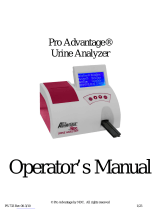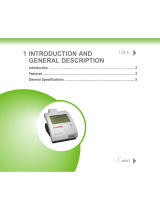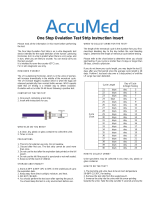
Urisys - Operator’s Manual V.
Units: Options are:
• Conventional units (mg/dL)
• SI units (mmol/L)
• Arbitrary units (+, +, +, +)
Either single units or combined units (conventional/arbitrary or SI/arbitrary) can be selected.
The operator selects a unit in which the results are to be stored, printed and/or transferred to a computer. After a new unit
has been selected, the repeat printout (activated by “Print Results”) and all following printouts and/or data transfer
(activated by “Send Results”) will be in the newly chosen unit.
Range Limits: For changing the reflectance range limits. Changing the range limits for the result intervals alters
evaluation sensitivity (see Sections . and .).
Language: This enables the display language to be set. The “Other” option allows the operator to choose between English,
German, Italian, Spanish and French.
Device ID: Displays the digits device ID, which is part of the factory settings and cannot be changed.
The device ID will also be sent to the host.
Operator ID: Choice between Normal and Authentication modes for the operator identification. If activated the input of
an operator ID will be required by the start of the instrument.
The Operator ID will appear in the result printout and will also be sent to the host PC. Authentication mode offers a lock-
out function and requires the ASTM protocol. (Refer Section . and . for details.)
Parameter (Par.): For selecting the order and number of parameters in the patient report and for “unidirectional” data
transfer.
To change the order or number of parameters in the patient report, press the function key on the left (“New”) with the
display showing “SEQUENCE PARAMETERS”. This calls up the first item in the patient report (“. PARAM.:”) followed by
the first para meter. Press “Yes” to confirm the parameter in the position shown. Pressing “No” causes the next test strip
parameter to be offered for the first position (display = “. PARAM.: PH”; etc.).
As soon as “Yes” has been pressed to confirm a parameter as the first item, the second item is shown with “. PARAM.:”
followed by the next, not yet confirmed, test strip parameter. Press “Yes” or “No” to select the parameter as the second
item in the patient report, and so on.
If there are any test strip parameters that are to be suppressed in the patient report, terminate selection following the most
recently confirmed parameter by pressing “START”.
You can undo the selection by pressing the “Default” function key when the display shows “SEQUENCE PARAMETERS”.
The Urisys system always measures and memorizes all of the parameters on whichever test strip is used. If, after
reading, you wish to reset the choice of parameters to the standard setting, you can reinstate the complete report through
the “MEMORY/Print” or “MEMORY/Send” menu.
Date/time: For setting the date and time.
The factory default is the date in Day-Month-Year order and the time in hours (-hour system) and minutes. If required,
the time can be displayed in the “-hour plus a.m./p.m.” system. Pressing the “Sequence” key allows the date format to be
changed to Month-Day-Year or Year-Month-Day. “Set” causes the date and time to be displayed and set. Pressing the left
function key (<<<) moves the blinking cursor to the left. The time or date unit highlighted by the cursor can then be
increased or decreased by pressing the keys (+ / -).
Pressing the START button confirms the setting, closes the submenu, and resumes Ready-to-Measure
status.


























